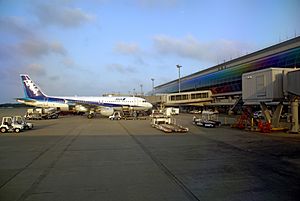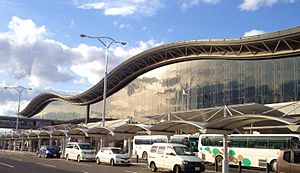Sendai Airport facts for kids
Sendai Airport (which is called Sendai Kūkō in Japanese) is an important airport in Japan. It is located in Natori, Miyagi, a city not far from Sendai. The airport is about 13.6 kilometers (about 8.5 miles) south of Sendai Station.
Sendai Airport handles many flights every day. These include flights that stay within Japan (domestic flights) and flights that go to other countries (international flights). It is officially known as a "2nd class airport" in Japan.
Contents
History of Sendai Airport
How Sendai Airport Started
Sendai Airport was first built in 1940 by the Imperial Japanese Army. It was used for military purposes. A few years later, in 1943, it became a flight school for the army.
After World War II
At the end of World War II, the United States Army took control of the airport. They managed all its operations for several years. In 1956, the airport was given back to Japan.
The Airport's Special Design
The main building of Sendai Airport has a very unique design. Its roof is curvy and wavy, made to look like the mountains and the sea nearby. This special building was finished in 1997. It was designed by an architect named Gyo Obata. The design is meant to show the hopes and dreams of the region.
Sendai Airport and the 2011 Tōhoku Earthquake
Damage from the Earthquake and Tsunami
In 2011, a very strong earthquake hit the Tōhoku region of Japan. This event is known as the 2011 Tōhoku earthquake and tsunami. Sendai Airport was badly damaged by the shaking. It was also flooded by the huge tsunami waves that followed the earthquake.
Helping After the Disaster
Even though the airport was damaged, it became very important for helping people. About a week after the disaster, military engineers worked hard to open the airport again. It was used as a central place to bring in supplies by air. Over 2 million tons of important items, like blankets, water, and food, were brought through Sendai Airport to help those affected.
Related Pages
Images for kids
-
A pillar on the terminal building's first floor denoting the maximum height flood waters from the 2011 Tōhoku earthquake and tsunami reached, 3.02 metres
See also
 In Spanish: Aeropuerto de Sendai para niños
In Spanish: Aeropuerto de Sendai para niños







